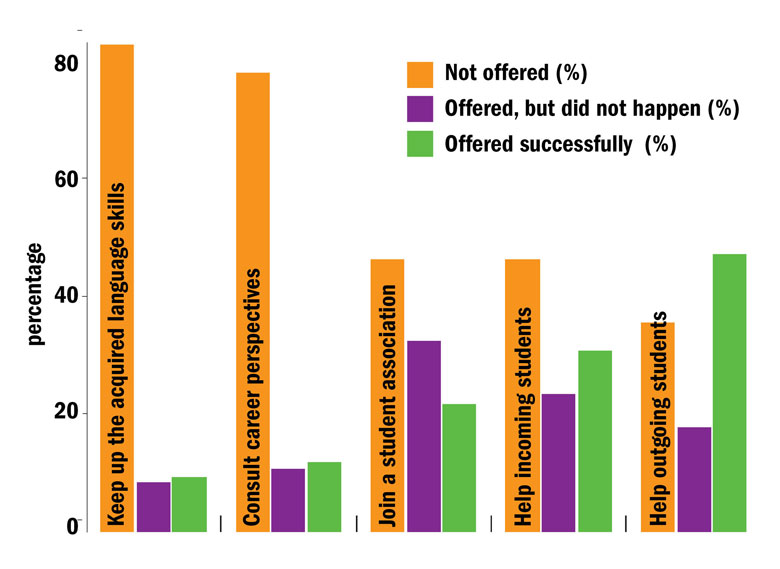Increasing the number of male students who study abroad is more challenging than improving participation among black and minority ethnic students, according to a study abroad expert at a US liberal arts college.
Samantha Brandauer, executive director of the Center for Global Study and Engagement at Dickinson College in Pennsylvania, said that in recent years the institution has focused on making study abroad “accessible for everyone”. However, although there are now “strong participation rates” among BME students, “we’re still working on the gender gap”. According to the Institute of International Education’s Open Doors 2015 report, 65.3 per cent of US students who studied abroad in 2013-14 were female – the same proportion as in 2012-13. The figure has remained relatively stable for the past decade.
Ms Brandauer said that 50 per cent of BME students at Dickinson College now study abroad, while 60 per cent of the total student cohort go overseas. She noted that the number of BME students at the university has increased in recent years.
However, she said that it has been harder to eliminate the gender gap in study abroad participation, which she said may be due to the fact that the university has been concentrating on “inclusion and diversification” on campus in general while white men were “the dominant culture already”.
She said that a key factor in improving participation rates among BME students and those from disadvantaged backgrounds has been enhancing financial support; the institution offers a loan for “high-need students” that enables them to pay for study abroad costs such as plane tickets and visas that often have to be settled before they receive their financial aid.
Ms Brandauer added that she has worked with the university’s existing mentoring programme, so that mentors can help “non-traditional” students understand that study abroad is available for them too.
“We have been looking recently at mentoring all of our students or using that mentoring model to help students that have traditionally been in the dominant culture [on campus] but haven’t been as engaged [in study abroad], ie, white men,” she said.
Belinda Robinson, chief executive of Universities Australia, agreed that promoting the benefits of study abroad to those from disadvantaged backgrounds and improving financial support have been the main factors behind the increase in the number of students going overseas from the country.
About one in six Australian university students (about 31,000) studied abroad as part of their degree in 2014, a fourfold increase since 2005 (7,282), according to Ms Robinson.
Of these 31,000 students, 2,300 were from non-English speaking backgrounds, 550 were from a low socio-economic background and 460 had a disability, she said.
She said that Australia has a “broader challenge” in encouraging students from all backgrounds to consider studying abroad given that the country is so far away from other nations, making it expensive to travel overseas.
“This is often compounded by the fact that students have to leave or quit part-time jobs without any reassurance [that they] have those jobs to come back to,” she said.
She said that Australia’s most successful initiatives in this area have been the government’s World Class programme, which focuses on using social media, careers fairs and video testimonials from students to promote the benefits of studying overseas, and the New Colombo Plan, which aims to support Australian undergraduates to study and undertake internships in the Indo-Pacific region.
The New Colombo Plan includes a scholarship programme for students to study abroad for up to a year and a mobility grants programme, which is benefiting from A$100 million (£58 million) of funding over five years from 2014.
Belinda Robinson is speaking about strategies for increasing study abroad participation among under-represented groups at 4pm on 14 September (Room 11B, Level 1, ACC).
Home truths: ‘aftercare’ limited
More than four-fifths of students who study abroad are not given an opportunity to keep up the language skills they acquired once they return to their home country, according to a survey.
A study by the Erasmus Student Network found that just 17.2 per cent of students who went overseas were offered a chance by their university to keep up the language skills gained abroad and just over half (9 per cent of the total) took up this opportunity.
In addition, just 22.1 per cent of students were given an opportunity to receive career guidance after studying abroad and 11.6 per cent did so.
The ESN Survey 2016 was carried out between October 2015 and January 2016 and received 12,365 valid responses from students. About 7,600 students responded to the question on availability of and participation in services after a period studying abroad. Study abroad participants helping outgoing students at their home institution was the most commonly offered service by universities; it was available to almost two-thirds of respondents (64.6 per cent) and taken up by almost three-quarters (73 per cent) of them.
Mikuláš Josek, ESN survey 2016 coordinator, will present the study data at 2pm on 14 September (Room 3A, Level 1, ACC).
Meet and greet: study abroad veterans are well placed to help new arrivals assimilate
Universities should call on domestic students who have experience studying abroad when looking for ways to welcome and integrate international students.
That is the view of Zainab Malik, research director of the British Council’s Education Intelligence team, who said that students who have returned home after a period abroad “can be fantastic ambassadors for international students”.
“They’ve been in that place where they’re new to an experience, new to an environment, don’t know anybody, and perhaps don’t speak the language very well,” she said.
“That’s a key population that can be called upon perhaps to further welcome and integrate international students.”
The British Council’s Broadening Horizons 2016 report, which surveyed UK students who have studied abroad and was published on 15 August, found that 91 per cent of respondents said that their overseas experience made them feel more strongly that domestic students should welcome and include international students.
Furthermore, 86 per cent of the students surveyed said that they empathised more with the issues that international students face, such as homesickness, and 80 per cent said that they were more likely to seek out friendships with international students after their own overseas experience.
Ms Malik said that “early stage inclusion” of international students “goes a long way”, citing collecting students from airports, arranging orientation sessions before classes begin, and introducing students to both domestic and overseas students, as ways that can help newcomers feel “more confident”.
She said that “it is the inclusion of those international students that really internationalises the campus and if you don’t include them then there’s isolation and perhaps poor academic performance and more seriously a risk to personal safety”.
Alessandra Rober Christensen, director of corporate partnerships at the Massachusetts Institute of Technology, said that international students’ successful integration into university life is “one of the key factors that positively affect retention rates”.
Alessandra Rober Christensen will be talking about ways to welcome and retain foreign students and staff at 4pm on 14 September (Room 11C, Level 1, ACC).
Register to continue
Why register?
- Registration is free and only takes a moment
- Once registered, you can read 3 articles a month
- Sign up for our newsletter
Subscribe
Or subscribe for unlimited access to:
- Unlimited access to news, views, insights & reviews
- Digital editions
- Digital access to THE’s university and college rankings analysis
Already registered or a current subscriber?





